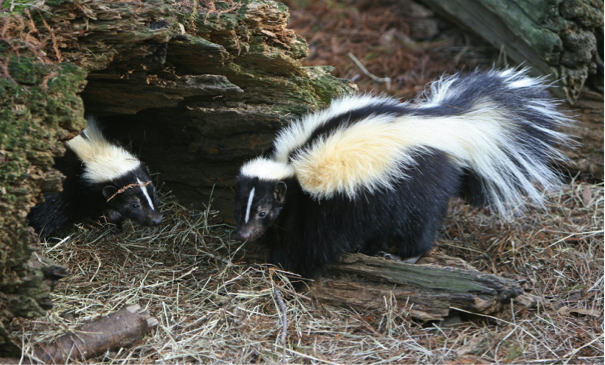Skunks
-
AboutTriangular-shaped head, short legs and long, sharp, non-retractable claws. Spray can be squirted accurately as far as six to 10 feet away as a defense mechanism. Live in burrows. Eat a varied diet. Excellent sense of smell and good hearing, but very poor vision. Healthy skunks are mild-tempered. They prefer to flee rather than fight. They usually only defend themselves when suddenly frightened, cornered, or harmed. In California, skunks are one of the most common carriers of rabies.

-
Signs/Symptoms
Offensive scent. Often spray dogs that bark and approach rapidly. They like to feed on ripening berries and fallen fruit and cause other garden problems by digging while in search of grubs and other insects. Often search for food in lawns by digging small pits or cone-shaped depressions three to five inches across. During the breeding season (February and March), males frequently spray when fighting over females. The presence of these odors in late winter is a signal that skunks might be nearby.
-
Where
They den under decks, porches, or beneath buildings. If other suitable dens are unavailable, skunks will dig their own dens. Skunks are attracted to residential areas by the availability of food, water, and shelter.
-
When
Skunks do not hibernate, so they can be seen at any time of year. Primarily active at dawn, dusk, and at night but can be active during the daytime, particularly in human-use areas.
-
Prevent
Habitat modification: Reduce access to food, water, and shelter. Remove fallen fruit and spilled birdseed. Put tight-fitting lids on garbage cans. Avoid placing food items in compost bins. Remove pet food by nightfall. Manage grubs and other insects in lawns. Cut back overgrown shrubbery and stack firewood tightly, preferably at least 18 inches above the ground. Remove boards, rocks, and debris lying on the ground, as insects that skunks feed on hide under these objects.
Exclusion: Close off openings under house, shed, porch, and deck with one-quarter inch mesh hardware cloth. If there is soil underneath the potential entrances, bury the wire at least six inches to discourage skunks from digging under.
-
Manage
Once skunks have made their home beneath a building, be sure the animals have left before blocking the opening. A few commercial products are available for repelling skunks, but are not very effective. Hire a professional wildlife control operator for trapping. Because rabies is endemic in the skunk population, some city or county health departments assist in the control of skunks by providing trappers to remove them from residential areas. Some private pest control companies will also trap and remove skunks for a fee.
-
More Information

